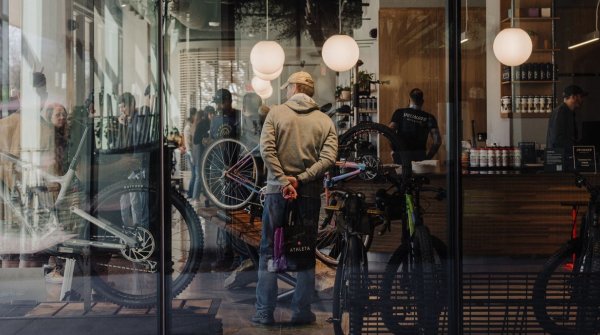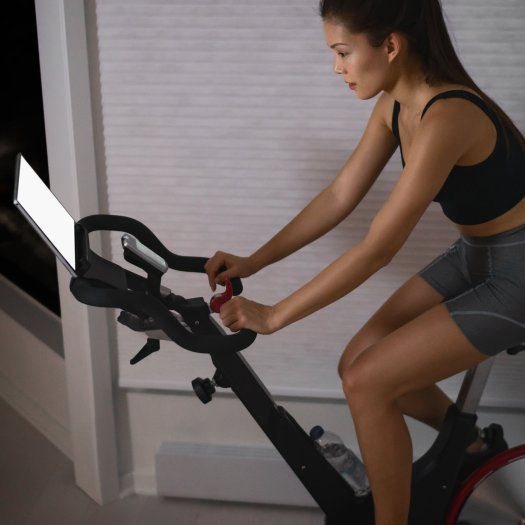Clearly, not every young entrepreneur builds a corporation that exceeds four billion dollars in annual sales ten years after its founding. And it's not all smooth sailing at fitness specialist Peloton either. The recent losses after the end of most corona restrictions and the decline in the number of new customers in recent months are causing problems for Peloton. The stock exchange company reacted promptly: co-founder John Foley handed over management of the company to ex-Spotify and Netflix manager Barry McCarthy. He should lead the company out of the crisis. The bad news: Peloton is still cutting jobs, every fifth employee should have to go. This is the only way to secure the company, as Peloton admitted.
No nice news from the fitness unicorn. But nevertheless, founders can learn a lot from the triumphant advance of the company from New York, which has done a lot right in recent years as a kind of "Apple of fitness" - thinks our author Jörg Heinrich, who has become an enthusiastic Peloton user in recent months. He presents ten exciting lessons learned.
Learning 1: Make it as easy as possible for your customers!
Anyone who bought a fitness bike in the past got a huge box delivered to their home with the bike's individual parts and assembly instructions. Assembling it was already the first fitness exercise. And when everything was finally screwed together, there were boxes, foils and Styrofoam scattered all over the room, which had to be laboriously disposed of. At Peloton two assemblers (in my case it was Dani and Premi) bring the bike, which weighs over 60 kilos, home, set it up at the desired location, put it into operation, explain everything and don't leave a shred of cardboard behind. That's included in the (steep) price. What they leave behind is a business card with a phone number and a parting greeting, "Call us if there are any problems." If, despite everything, you're not satisfied with your bike or treadmill, you can return it free of charge for 30 days. Then Dani, Premi or two other colleagues come by again - and drag the heavy thing back down. Wonderful!
Learning 2: Show your customers that they can rely on you right from the start!
Sounds simple, but it's anything but. Anyone who orders a Peloton device can not only choose the day on which it is delivered - but even the two-hour window in which the fitters arrive. And that actually works, at least in my case. Between 10 and 12 o'clock was agreed, with an order duration of only twelve days for a Peloton Bike+. And shortly after half past ten, Dani phoned to say that he would be there in ten minutes with Premi and my new bike. Anyone who has ever waited all day at home for the heating meter reader, who then doesn't come after all, appreciates that very much.
Learning 3: Make spending money as comfortable as possible for your customers!
Peloton is expensive, no question. The bike starts at 1,495 euros, and the Bike+, like the Tread treadmill, at 2,495 euros. In addition, there is a subscription fee of 39 euros per month for the trainers and courses. If you're going to spend that kind of money, you want it to be as easy and convenient as possible? Peloton gets that right, too. If you don't want to pay for your equipment right away, you can finance it from 59 euros a month at zero percent interest. It's fast and convenient. And the remaining amount can be paid in full at any time during the term, if desired.
Learning 4: Don't confuse your customers with dubious tariffs that nobody but you will understand anyway!
As expensive as Peloton is, there is at least no tariff confusion with one, two or four users and various options, with and without HD, or with 4K. The 39-euro subscription is always valid for the entire household, i.e. for the buyer(s), the partner(s), or the children. And it always includes the complete training offer.
But even for Peloton, growth is not a foregone conclusion. The slump in new customer numbers that became known at the beginning of 2022 is a warning signal. The additional $250 to $350 delivery and set-up fees for customers in the U.S. since the end of January 2022 are also likely to be a damper on new customer acquisition.
Learning 5: Give your company a face - and show your customers that you are likeable and that it is fun to buy from you and use your offers!
The best thing about Peloton is the 50 or so trainers and instructors who lead the classes on screen. The tough Robin Arzón, the super friendly Ally Love, and Peloton beau Cody Rigsby, who danced on the U.S. version of "Let's Dance" in 2021, are now veritable pop stars with fans all over the world. They are omnipresent on Instagram. And northern German surfer girl Mayla Wedekind, who holds German-language classes out of the Peloton studio in London, is also becoming increasingly popular. They all ensure that each Peloton subscriber last completed 16.6 classes per month. For home gym equipment that likes to gather dust in the basement, that's an excellent rate - even if the number was significantly higher during the Corona lockdowns at 26 workouts per month.
Learning 6: Think about what clever social features, collaborations or contests could be fun for your users and boost your business!
Virtual bike races like competitor Zwift Peloton customers cannot race against each other - many users would like to see such an update. But what is enormously motivating is the leaderboard on the right side of the screen. This shows exactly where an athlete's energy consumption is during the course compared to the "competition". There is the option to push and reward each other with high-fives. And pelotonies who "follow" each other (there's that here, too) can even watch each other work out with a camera on the screen - although few people reportedly use that. Much more popular: Those who follow each other and complete the same courses receive special partner medals for doing so.
Learning 7: Think carefully about what is important in your product or your offer - and what you can possibly leave out to save costs!
You can tell by looking at a Peloton bike where the development priorities were - and where they weren't. The steel and carbon fiber construction is solid as a rock and should last for years or even decades. And the speakers, especially on the Bike+, each with two tweeters and woofers radiating to the front and rear, are excellent. Welcome to the home disco! Clearly, music is one of the most important elements on any Peloton course - and it needs to sound good and loud. The up to 23.8-inch screens, on the other hand, turn out rather disappointing with only 1080p HD resolution and cannot keep up with a current iPad. This is because a display in this size with Apple's Retina resolution would be much too expensive. Besides, no one pays attention to individual pixels on the screen when exercising anyway. Cleverly done.
Learning 8: Even if it's not always easy from a copyright point of view - think of a way to integrate music into your offer so that your customers are in an even better mood!
Without the two million songs Peloton has licensed for its workouts, the courses wouldn't even be conceivable. With music, slogging and sweating are much more fun. And the "Artist Series" from ABBA to Beyoncé to Metallica, in which only songs by the respective artists are played, is one of the big attractions. The way Peloton integrates the user's personal music library is excellent: During the courses, each piece of music can be likened with a heart. These songs then end up as Peloton playlists in the user's own account on Spotify or Apple Music. This way, you can always discover new music or music you haven't heard in a long time.
Learning 9: Plan exactly which updates and changes really offer added value to the user (or to you), and don't keep changing your offer and your products!
Although Peloton has been around since 2012, the company has basically only offered four products so far - two versions of its bike and two variants of its treadmill Tread. Updates only come when innovations really make sense and add value for users. For example, compared to the normal bike, the Bike+ offers a larger screen, more powerful speakers and, most importantly, "Auto Follow" - the practical function that automatically adjusts the resistance to the trainer's specifications when pedaling during recorded courses. In addition, the Apple Watch can be wirelessly connected to the Bike+ for heart rate monitoring and workout recording, which works first-rate. These innovations are so useful for many customers that they therefore spend 1,000 euros more for their Plus bike.
Learning 10: Think about how you can get your customers to spend money with you regularly - not just once!
As high as the prices for the Peloton devices are, the company's great potential lies in the 39-euro subscription that users* pay month after month. Revenue from those contracts skyrocketed from $181 million annually to $872 million between 2019 and 2021 during the pandemic. "They have an absolutely insane software gross margin. And that's what Peloton is all about," explains analyst Andrew Mitchell.
 Sports BusinessThe future of the bike industry: 6 innovative bike stores
Sports BusinessThe future of the bike industry: 6 innovative bike stores
- ISPO awards
- Mountain sports
- Bike
- Design
- Retail
- Fitness
- Health
- ISPO Job Market
- ISPO Munich
- ISPO Shanghai
- Running
- Brands
- Sustainability
- Olympia
- OutDoor
- Promotion
- Sports Business
- ISPO Textrends
- Triathlon
- Water sports
- Winter sports
- eSports
- SportsTech
- OutDoor by ISPO
- Heroes
- Transformation
- Sport Fashion
- Urban Culture
- Challenges of a CEO
- Trade fairs
- Sports
- Find the Balance
- Product reviews
- Newsletter Exclusive Area
- Magazine





